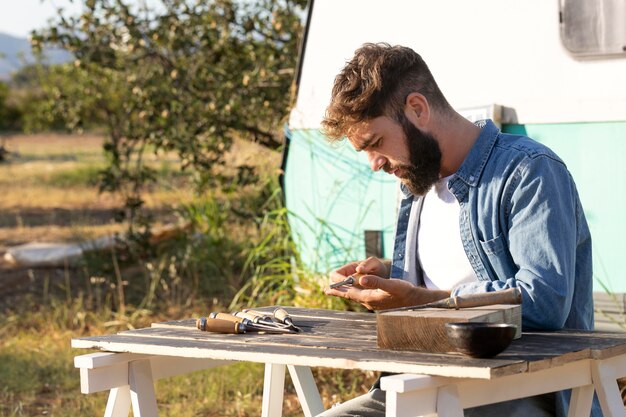Unplugged: How to Create Your Perfect Off-Grid Sanctuary
In an age of constant connectivity and bustling urban life, the idea of stepping away from it all and living off the grid is more appealing than ever. For some, off-grid living represents an opportunity to disconnect from technology, embrace sustainability, and reconnect with nature. Whether you’re considering a part-time retreat or a full-time lifestyle, creating your off-grid sanctuary requires careful planning, resourcefulness, and a clear vision. Here’s how you can turn your dream of living off the grid into reality.
1. Choosing the Right Location
The first step in creating your off-grid sanctuary is choosing the right location. Ideally, you want a place that offers peace, privacy, and access to the resources you’ll need to live independently. Consider the following factors when selecting your land:
Climate:
The climate will dictate much of your off-grid strategy, from how you heat your home to how you manage water and waste. Choose a location with a climate that suits your lifestyle, whether that’s a warm, sunny area for solar power or a cooler climate where you can use natural materials like stone for insulation.
Water Source:
Freshwater is one of the most important resources when living off the grid. Look for land with access to a natural water source like a well, stream, or river. If this is unavailable, you’ll need to plan for water storage and rainwater harvesting systems.
Access to Resources:
Off-grid living doesn’t mean complete isolation. It’s wise to be within a reasonable distance of a town or city for supplies, medical needs, and occasional visits. Being too remote can lead to difficulties with deliveries and emergencies.
2. Building Your Off-Grid Home
Once you’ve secured the perfect location, it’s time to think about your living space. Building an off-grid home requires a sustainable approach, balancing comfort with efficiency. Here are key considerations for your home’s design:
Energy Efficiency:
One of the core aspects of off-grid living is reducing your reliance on outside power sources. Consider using energy-efficient materials such as straw bales, adobe, or hempcrete for insulation. Your home should be designed to minimize energy consumption, utilizing passive solar heating, proper ventilation, and maximizing natural light.
Renewable Energy Systems:
The heart of an off-grid home is its energy system. Solar panels are the most common and reliable source of energy for off-grid living. Wind turbines and micro-hydro systems are also viable options depending on your location.
Choose a renewable energy setup that fits your needs, ensuring that it can provide enough power for your home’s lighting, appliances, and heating systems. Backup energy sources like a small generator may be necessary during periods of low energy production.
Water and Waste Management:
Off-grid living demands a sustainable approach to managing both water and waste. One key solution is installing a rainwater harvesting system, which captures rainwater from your roof for uses such as drinking, bathing, and cooking.
In addition to water collection, consider integrating composting toilets, gray water systems, and septic tanks to minimize your environmental footprint while ensuring the efficient operation of your waste management systems. For those in areas like Utah, where water availability can be limited, well drilling can also be a valuable option to secure a reliable and independent water source.
3. Sustainable Living Practices
Living off the grid isn’t just about your home—it’s about creating a lifestyle that’s self-sufficient, sustainable, and in harmony with nature. Here are some ways to live more sustainably in your off-grid sanctuary:
Food Production:
Growing your food is one of the most rewarding aspects of off-grid living. Start with a garden to grow vegetables, fruits, and herbs. Depending on your space, you could also keep chickens for eggs or even small livestock for meat. Greenhouses or cold frames can extend your growing season, and permaculture principles can help you design a food system that works with the natural landscape.
Waste Reduction:
Off-grid living encourages minimalism and waste reduction. Composting organic waste is a great way to recycle nutrients back into your garden while repurposing materials and reducing single-use plastics will lower your environmental footprint. Be mindful of how much waste you generate and how it can be sustainably disposed of or reused.
Alternative Heating and Cooling:
Without traditional utilities, you’ll need to be resourceful about heating and cooling your home. Wood stoves are a popular choice for off-grid heating, providing both warmth and a cozy ambiance. Earth homes, built partially into the ground, naturally maintain a consistent temperature year-round. Proper insulation and passive solar design can reduce the need for heating and cooling, making your home comfortable year-round without relying on external power.
4. Creating a Connection with Nature
Living off the grid is as much about embracing a simpler, more grounded way of life as it is about sustainability. To truly create your perfect off-grid sanctuary, connect with the land and the natural world around you.
Outdoor Spaces:
Design your off-grid home to incorporate outdoor living areas where you can relax, meditate, or entertain. Build a deck, a garden path, or even an outdoor kitchen to make the most of your natural surroundings. Creating spaces for reflection and enjoyment outdoors will help you cultivate a deeper connection to your environment.
Mindful Living:
Living off the grid often means reducing distractions and focusing on the present moment. Use this opportunity to cultivate mindfulness, whether through gardening, hiking, or simply enjoying the tranquility of nature. Being off the grid provides a unique chance to reconnect with yourself and the Earth.
5. The Journey to Independence
Creating an off-grid sanctuary is not a one-time project—it’s an ongoing journey that will require adaptability, patience, and continuous learning. As you build your home and establish your lifestyle, you may encounter challenges, but each obstacle will be an opportunity to improve your systems and refine your self-sufficiency.
Living off the grid is about embracing a slower, more intentional lifestyle that prioritizes sustainability, resourcefulness, and connection to nature. By thoughtfully planning your off-grid home and making conscious decisions about your energy, water, and waste systems, you can create the sanctuary of your dreams—one that is truly unplugged and self-sustaining.






